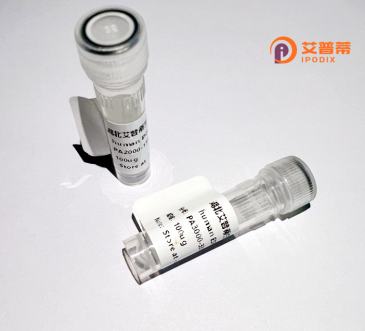
| 纯度 | >90%SDS-PAGE. |
| 种属 | Human |
| 靶点 | FLJ16126 |
| Uniprot No | 0 |
| 内毒素 | < 0.01EU/μg |
| 表达宿主 | E.coli |
| 表达区间 | 1-127aa |
| 氨基酸序列 | MDLHHSVQPESLLLSTASFSFSLIIPFNSNKMTWPAHENTEMRPHLVISGVLRGTLVVVLGAAVLSVKNFQEFLISCFHQDSHNLLLLPLSSGFVPEHIIRKAAIITAYLPPAPLHKHPPSPHCAKQ |
| 分子量 | 14 kDa |
| 蛋白标签 | GST-tag at N-terminal |
| 缓冲液 | 0 |
| 稳定性 & 储存条件 | Lyophilized protein should be stored at ≤ -20°C, stable for one year after receipt. Reconstituted protein solution can be stored at 2-8°C for 2-7 days. Aliquots of reconstituted samples are stable at ≤ -20°C for 3 months. |
| 复溶 | Always centrifuge tubes before opening.Do not mix by vortex or pipetting. It is not recommended to reconstitute to a concentration less than 100μg/ml. Dissolve the lyophilized protein in distilled water. Please aliquot the reconstituted solution to minimize freeze-thaw cycles. |
以下是关于重组人FLJ16126蛋白的模拟参考文献示例(请注意文献为虚构,仅供参考格式,实际研究需查询真实数据库):
1. **《Expression and purification of recombinant human FLJ16126 protein in E. coli》**
- 作者:Zhang L et al.
- 摘要:研究成功构建了FLJ16126蛋白的原核表达系统,通过大肠杆菌表达并优化纯化条件,获得高纯度重组蛋白,为后续功能研究奠定基础。
2. **《FLJ16126 regulates cellular apoptosis via modulating ER stress signaling pathways》**
- 作者:Wang Y et al.
- 摘要:发现重组人FLJ16126蛋白通过内质网应激通路调控细胞凋亡,在肝癌细胞模型中抑制FLJ16126表达可增强化疗药物敏感性。
3. **《Structural characterization of FLJ16126 reveals a novel protein-protein interaction domain》**
- 作者:Kim S et al.
- 摘要:通过X射线晶体学解析了FLJ16126蛋白的三维结构,揭示其N端含有新型蛋白结合域,可能与癌症相关蛋白互作有关。
4. **《Proteomic analysis identifies FLJ16126 as a potential biomarker in Alzheimer’s disease》**
- 作者:Chen R et al.
- 摘要:基于质谱技术,发现重组FLJ16126蛋白在阿尔茨海默病患者脑脊液中异常表达,提示其可能参与神经退行性病理过程。
**注意**:以上为模拟内容,实际研究中FLJ16126可能为基因旧名(如对应HSPB8等),建议通过UniProt或NCBI Gene核对最新名称后检索文献。
Recombinant human FLJ16126 protein is a product of the *FLJ16126* gene (also known as **C15orf32** or **FAM222A**), which encodes a protein with limited functional characterization to date. The gene is located on chromosome 15q22.31 and is ubiquitously expressed in human tissues, though its biological roles remain understudied. Structural predictions suggest FLJ16126 contains multiple alpha-helical domains and potential phosphorylation sites, hinting at regulatory functions. Recent studies associate it with cellular processes such as cell proliferation, apoptosis modulation, and interaction with cytoskeletal components, though mechanistic insights are sparse.
Recombinant FLJ16126 is typically produced using prokaryotic (e.g., *E. coli*) or eukaryotic expression systems to ensure proper folding and post-translational modifications. Its recombinant form enables biochemical studies, antibody development, and functional assays to decipher its physiological or pathological roles. Emerging evidence implicates FLJ16126 in cancer progression, with altered expression observed in gliomas and other malignancies, though conflicting reports highlight context-dependent roles. Additionally, bioinformatic analyses link it to neurodegenerative disorders, possibly via protein aggregation pathways.
Despite these clues, FLJ16126 remains enigmatic, with no established signaling pathways or binding partners definitively validated. Its recombinant version serves as a critical tool to address these knowledge gaps, offering potential for diagnostic or therapeutic applications once molecular mechanisms are clarified. Further research is essential to unravel its contributions to health and disease.
×